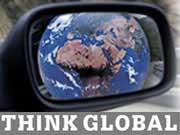May 18, 2005
 |
| The Walker Art Center hopes to use its new building to create a more global dialogue about art. (Photo courtesy of Walker Art Center) |
Minneapolis, Minn. — A few years back, the Walker Art Center decided its world view was too narrow. It launched a three year partnership with curators and scholars from around the world to find the new and different ways artists are expressing themselves.
The experience changed how the Walker looks at and presents art.
Walker Art Center Director Kathy Halbreich says different cultures hold up different truths, but that doesn't mean that one of them is less valid than another.
"Culture, like geography, is specific," says Halbreich. "As curators of global culture we need to understand better those histories, those values which have shaped the countries where artists come from that we support."
Thus you're as likely to see Japanese anime, or Minnesotans performing Javanese-inspired dance at the Walker as you are an Andy Warhol portrait. Halbreich says the exhibits are part of the Walker's attempt to create a more global dialogue around art. She hopes other arts institutions will follow suit.
"What I think Walker has done is fire the first salvo in a change that was bound to happen to all cultural institutions," says Halbreich. "Which is to maintain the excellence of the artistic programs but a less authoritarian approach to how we deliver those programs, a more personable approach to how we talk about those programs."
Halbreich says that means relying less on traditional European notions of art.
Chief Curator Richard Flood says much of the creative work on this planet is unknown outside of its own country, and the Walker Art Center is attempting to change that. But even if the Walker wasn't presenting artists from around the globe, Flood says the art world would inevitably have to change its ways.
"I think we're at a point in the history of civilization where we're going to have to respond to globalism; I don't think you go out and pick it," says Flood. "It's a provocation and it's an invitation for change in all the best ways, so not to embrace globalism would be very very silly."
Performing arts curator Phillip Bither agrees. Bither sits in the Walker's new performance space. The theater's opening festivities featured a performance by dancers from Pakistan. Bither says globalization has redefined what the Walker thinks of as contemporary art and performance.
"We now look to Asia, Africa and Latin America to find the newest innovations and even only 15 to 20 years ago we would just look to Europe and North America," says Bither.
Sometimes cultures connect, but other times they collide. Bither says unfortunately since September 11, 2001, it's been harder to present international performances.
"It's been much much more difficult to bring artists from overseas here because of threats around terrorism have caused us as a country to become very restrictive about who's allowed in," says Bither. "The Walker is fighting it every step of the way."
Bither says he now regularly lobbies for artist visas, something he rarely had to do in the past. He says such international tension makes the Walker's work even more important as an educational and healing force.
"Inevitably when we bring artists from far away lands the people who come in contact with those artists, their notions of what those countries are like completely change," says Bither. "All of the preconceptions and stereotypes fall away and the people-to-people contact I think is a hopeful direction for diplomacy in the future, hopefully lowering tensions in the world."
Bither says while national security makes it more difficult for him to bring in touring artists, he believes presenting international artists is central to ensuring the nation's long term security.







